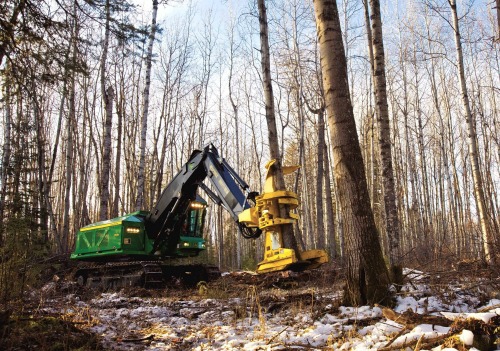
New Gear
Harvesting
New Gear
Winterizing your equipment
Oct. 6, 2016 - As the temperatures begin to drop, now is the time for loggers to ready their machines for cold weather. There are key areas that loggers should be focusing on ensure that their machines are ready to go when the first frost arrives.
October 6, 2016 By Ray Leclerc

1. Hydraulics
Examine the hydraulic oil and filter, changing if required. Cross-reference your manual, ensuring that your fluid levels and grade are correct. Check the hydraulic tanks breathers, change filters as necessary, and ensure that the suction hose is in good shape and clean the suction filter inside the tank. Make sure that the hose is not damaged or leaking. Test the hydraulic system to ensure that it reaches the operating temperature. Additionally, inspect the hydraulic oil cooler and mounts, as well as the cooler shrouding. On the latter, make sure that it is free of cracks and that the foam is present. Finally, check the oil grade and condition of the final drive/differential.
2. Engine
Prior to colder weather arriving, change out your oil and filter to the proper oil grade for the winter months. Take a coolant sample, checking the coolant level and condition. As you are doing this, look for any leaks and repair as necessary. Inspect the engine fan belt, ensuring that it has the proper tension and not cracked or damaged. Look for leaks, rubber damage or any debris on the engine balancers, and replace any parts based on your owner’s manual. Monitor your engine, ensuring that it achieves and maintains the running temperature. Also, look at the coolant temperature going in and out of the heat exchanger of the cab, and confirm that the defrost ducts are present and functioning, keeping windows clear. Make sure that the radiator and mounts are in good condition. Check the charge air, including mounts, rubbers tubes and clamps. Finally, take a fuel sample and ensure that the fuel and your reservoir are in good shape and that there is no water on the bottom. If you are equipped with an engine or block heater, test and confirm that it will reach the recommended operating temperature.
3. Electrical Components
Check the machine start and connectors, confirming everything works. Perform a starter test, making sure it is not drawing too much power, and measure the voltage drop on your starter cables. Inspect all high tension wires for wear marks or loose fasteners, as well as all grounds and ground straps, ensuring they are well fastened. Refresh your battery, cleaning and washing the battery box and casing, and remove battery wires and clean all battery terminals and spray protectant on the battery posts. Plan to test your batteries individually to see if they are working properly. Finally, load test your alternator and confirm that the output is to spec.
4. Differentials
Take oil samples, and cross reference the oil grade with the service manual based on the temperature of operation. If required, change the oil and filter. Additionally, inspect the magnetic drain plug for debris if equipped. Finally, check for any leaks or overfilling.
5. Operator Cab
Check the wiper motor (if equipped) and replace wiper blades as needed. Make sure your cab bulbs and window and doors sealers are present and in good working order. Referring to your maintenance manual, make sure that the escape hatch is functional and, if equipped, check the fire suppression system. Work with your dealer to make sure any software on your machine is up-to-date.
6. Transmission
Make sure your transmission is ready to go, taking an oil sample to check the type and grade. Reference your service manual and replace based on the temperature of operation. Check the cooler and mount, as well as drivelines. As you inspect, look for any leaks and keep an eye out for wires rubbing. Finally, make sure the gears are smooth while shifting up or down, and ensure that the temperature and performance is within specs. If required, calibrate your transmission.
7. Undercarriage
Perform a machine walk around, evaluating the undercarriage. Inspect the machine rollers, ensuring that you can access the fasteners. Also check the tires, looking at the condition and replacing as needed. Examine the chains, looking for any wear and needed maintenance.
Ray Leclerc is a Territory Customer Support Manager for John Deere.
Print this page